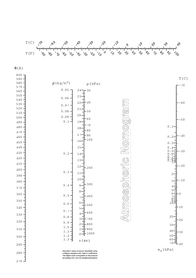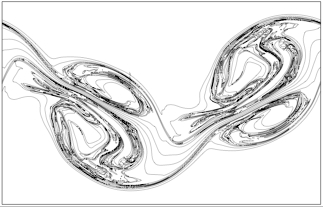Atmospheric Nomogram
See also: Ambaum, M. H. P., 2007: A nomogram for the atmosphere.
Weather, 62,
344-345. doi:10.1002/wea.141
... and also: the resources page for my Thermal Physics of the Atmosphere book for another version of an atmospheric nomogram.
A nomogram is a diagram that can be used to graphically perform
a certain calculation. For example, given temperature and pressure, what
is the potential temperature. We can get the calculator out and do
this calculation or, if you are a bit more hard-core, log tables or a slide rule. Either way
would work but it becomes rather cumbersome if you have to do it
ten times in a row. In that case it might be more useful to write a little
computer program or use a programmable calculator. Another way would be to
produce a nomogram.

Click on the image to download your nomogram which can be
printed on any laser printer. Read on for instructions.
A nomogram is a sheet of paper with graduated scales (for
example for temperature, pressure, and potential temperature). We then put
a ruler over the nomogram crossing the temperature scale at the given
temperature value and the pressure scale at the given pressure value. Where
the ruler crosses the potential temperature scale the potential
temperature value
can be read off. Of course this process can be generalized: given
potential temperature and pressure we can read off the corresponding
temperature. In this sense a nomogram is quite flexible.
The nomogram above contains four graduated scales: for potential
temperature, density, pressure, and temperature. We can choose any two of
these and read off the other two using the ruler. But there is more: the
temperature scale also shows a saturated vapour pressure scale, and the
pressure scale also shows a 1976 US standard atmosphere height scale, so
these two quantities can be thrown in the mix as well. For good measure I
included a Celcius-Fahrenheit converter, which consists of a seperate linear
scale with two graduations, the simplest form of nomogram possible.
There are several books about construction of nomograms, most, if not all
of them out of print. My nomogram consists of
cleverly scaled and placed logarithmic scales. The devil is in the detail
though: it took me quite a bit of time to work out the exact locations and
optimal scalings. Making a basic nomogram is easy; making a nomogram with
the right ranges which has readable scales and which incorporates two
calculations at the same time is rather less easy.
In all, I hope you find it a useful tool to do some simple calculations
commonly encountered in atmospheric science. I am open to any suggestions
for improvement.
Instead of a ruler I found it useful to get an overhead transparancy and
draw a straight coloured line on it and use this as the index line. This
makes the reading off of the nomogram a bit easier.
And for the geeks out there: this nomogram was made through
straight postscript programming.
The postscipt code contains a bracketing routine to locate the saturated
vapour pressure graduations on the temperature scale. Postscript
printers are essentially big programmable RPN calculators and are ideally
suited to produce graphics such as these: the locations of the scales and
their graduations are calculated by the printer itself before they are
plotted.
<rant>
It is real a shame that it is nearly impossible to
find simple RPN
calculators these days (HP produces a few models.) In fact, it is difficult to find any simple
scientific calculator anymore: most modern calculators have cumbersome, error-prone
input methods (I see my students struggling with them) and have so many functions on them (none of which you will
ever use) that you wonder if you can also fry an egg with them.
Anyone who has ever used an RPN calculator, or who
has done postscript programming, will realize that RPN notation is easy,
intuitive, fast, and compact (see Wikipedia page on RPN
for a description.) Furthermore, you are much less likely to make
errors. It is also not very difficult to learn, as you would expect from a
truly intuitive system; when you know the basics, it takes about half a minute
of practice. It is a
shame that HP does not produce its old scientific RPN calculators
anymore as legacy models. If anyone who is reading this owns an old HP-11C, HP-15C or HP-42S: I am
interested in buying it!
</rant>
<rant2>
Well, I need to add a postscript to the above rant: since I wrote it much progress has happened on the RPN calculator front. HP has released a few more models (most notably the 35s, and a special edition of the 15 - both lovely machines). But best off all: an electronic engineering workshop in Switzerland has now started building and developing RPN calculators inspired on the old HP models. Their top of the range model is an improved verion of the 42, the DM42. It is an absolutely incredible machine, and probably the calculator that makes all other calculators superfluous. The company is called Swissmicros. I am not alligned with these guys at all, but their products are just awesome. If you want an old school RPN calculator with the latest features added in (USB connectivity, for example) that runs circles around any other calculator on the market these days - look at the DM42.
</rant2>







